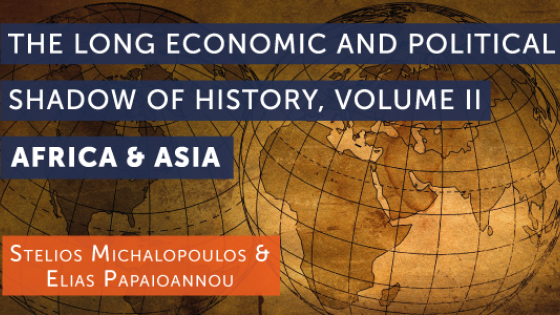Since WWII, some nations have grown, others have stagnated, and yet others have failed utterly. Understanding the ‘why’ behind these diverse outcomes is arguably one of the most important tasks facing today’s economists. The livelihoods of billions of humans depend upon it. To paraphrase Nobel Prize winner Bob Lucas’s famous remark, once one starts thinking about the vast disparities in economic performance, it is hard to think about anything else.
The chapters in this eBook:
Download: The Long Economic and Political Shadow of History, Volume 2 | Africa and Asia
summarise many of the contributions that economic history has made to solving the grand puzzle of persistent differences in economic outcomes. Relying on historical analysis, the chapters explore the influence of geography and culture along with landmark historical events including colonisation, large-scale migration, and revolutions.
The focus of this eBook – which is the second in a three-volume series – is on the insights that economic historians have developed in regards to countries in Africa and Asia. It builds on Volume I – The Long Economic and Political Shadow of History, A Global View – which focused on more general themes in how economic history help explain persistence differences in economic performance.
The deep origins of African development experiences
Volume 2 starts with chapters that discusses works on the deep origins of African development and underdevelopment. They include considerations of the impact of the slave trade, differences in colonial experiences, and the impact of the various independence movements.
The legacy of Africa’s slave trades – which lasted from the 1400s right up to the late 19th century – is the focus of Chapter 1. The author, Nathan Nunn, summarises the evidence he gathered on how four waves of slave trade created a toxic, long-lasting effect in Africa. African regions that include countries like Angola, Nigeria, and Sierra Leone were profoundly affected by the slave trade. Even today, they are less developed compared to territories, like Botswana, which were shielded from slavers by isolation. Nunn further shows that, if anything, the slave trades affected more the relatively more advanced parts of pre-colonial Africa, thus linking enslavement to a continental reversal of fortune. Lastly, Nunn reviews empirical studies that shed light on the mechanisms at play. These suggest that the enslavement-underdevelopment link operates via distrust, conflict, a culture of authoritarianism, and a higher degree of ethnic fractionalisation.
Chapter 2, which we wrote, reviews research on the impact of the artificial borders that were drawn by European colonialists during the ‘Scramble for Africa’ in the late 19th century. The evidence follows two main axes. The first highlights how the partitioning of ethnic groups by national borders is associated with current conflicts. We show that the likelihood, duration and intensity of political violence are all higher in ancestral homelands that were split by modern borders. We also show that ethnic partitioning is related to ethnically based discrimination and repression, often leading to major ethnically tainted civil wars. The second axis looks at how partitioning that was unrelated to ethnicity also had long-lasting consequences. Here, we focus on the peculiar sizes and shapes of many African countries, the preponderance of landlocked states, and their ethnic diversity.
In Chapter 3, Tristan Reed reviews works on the legacy of the so-called ‘indirect rule’ – a colonial strategy that involved ruling via existing rulers. The particular case examined is the chieftaincy system in Sierra Leone. As it turns out, local political power in contemporary Sierra Leone is in the hands of families whose ancestors were appointed by the British as paramount chiefs during the late 19th century. These families have effectively ruled the local communities not only during the colonial time (as British representatives), but throughout most of the country’s post-independence period. An interesting finding is that political competition – as reflected in the number of ruling families in each chieftaincy – is correlated with better development outcomes.
In Chapter 4, Sara Lowes and Eduardo Montero summarise their ongoing work on the legacy of forced labour practices and terror focusing on King Leopold’s rule of Congo Free State. The authors compare various development proxies (education, wealth, health) between two different sets of areas: those that were violently ruled via mercenaries employed by private companies that had concessions for rubber, and nearby territories that did not have to produce pre-specified amounts of rubber. Living conditions today are considerably worse in areas where mercenaries were coercing the local population to produce rubber, as compared to neighbouring areas that were not part of Belgian concessions. They also show that traditional leaders (chiefs) are less accountable and of lower quality in regions that suffered a great deal during King Leopold’s rule, suggesting that dysfunctional local institutions may be a source of persistence. Interestingly, however, the authors find a higher level of trust and civicness in the concessionary areas, suggesting that, in this case at least, trust and local institutions are substitutes.
The impact of colonial investments in railroads on African economic geography is the focus of the Chapter 5 by Remi Jedwab, Edward Kerby, and Alex Moradi. Drawing on their recent work, the authors show that connecting large cities and promoting inter-city trade was not of interest to colonial powers. Military considerations and accessibility to mine-rich areas were more important factors, and, as the authors document, this quite often resulted in African colonial railroads that today go from nowhere to nowhere. This initial railroad network nevertheless helped to shape population density and the location of economic activity during colonial times. Cities were formed close to the railroads, and over time they developed faster than areas far from the railroads.
But the most interesting finding regards the most recent period. Even though post-independence, many railroads stopped being used (because of conflict, mismanagement, and lack of resources) and the road system became much more important, locations along the old railroad lines are still more populous and more developed. This finding, which is consistent with new economic geography theoretical models on inertia, reveals how early colonial policies (on infrastructure, in this case) can have long-lasting effects.
The next chapter turns the spotlight of economic history on the role of Christian missions in Africa. Julia Cage and Valeria Rueda draw on the key role missions played in the provision of education and health. Drawing on their recent work, they present evidence on the heterogeneous effects of Christian missions. First, they show that proximity to historical Protestant missions with a printing press is associated with higher levels of trust, higher readership of newspapers, and higher levels of social capital today. In contrast, proximity to Protestant missions without a printing a press is unrelated to social capital proxies. This result sits comfortably with the important work of Dittmar (2011) on the quantitatively strong impact of the printing press on urbanisation and growth in Europe. Second, they report on ongoing research examining the effects of Christian missions on contemporary health, and HIV prevalence in particular.
Chapter 7 assesses how differences in the way that the colonial era came to an end across African countries have left their imprint on subsequent institutional outcomes. Specifically, Leonard Wantchekon and Omar Garcia-Ponce show that contemporary political development in Africa is related to the type of independence liberation movements. Countries that experienced rural insurgencies, where the liberation movement was especially strong in the rural areas and the leaders tried to weaken colonial state with rural fighting (e.g. Kenya, Madagascar, Mozambique), have more autocratic regimes today. In contrast, African countries where the independence movement took the form of non-violent urban protests (e.g. Ghana and Tanzania) have more democratic governments. To push on causation, the authors apply an econometric technique that isolates the component of rural-urban insurgency driven by geography.
Economic history and Asian development
The second part of this volume goes over studies that focus on India, China, and Australia.
Chapter 8 focuses on the case of India. Lakshmi Iyer summarises her work on the long-run consequences of direct versus indirect colonial rule in the subcontinent. Iyer exploits the fact that 45% of the total area and 23% of the Indian population were not under direct British colonial rule. The really revealing variation comes from a policy that led the British to annex states where the ruler died without a natural born heir. Her findings suggest that states that came under direct British rule in this way had significantly lower provision of public goods such as access to health centres and transportation infrastructure. She argues that this outcome resulted from the fact that rulers of princely states tended to be deposed by the British for misrule. British colonial administrators, by contrast, faced no such penalty for delivering poor outcomes.
In Chapter 9, Ruixue Jia traces the economic performance of prefectures with treaty ports in China over time, uncovering how oscillating between periods of openness and closedness shaped development outcomes both in the short and long run. Jia constructs a prefecture-level dataset from 1776 and 2000 and finds that although prefectures with treaty ports compared to those with no-treaty ports grew faster before the Communist Revolution in 1949, the two sets of regions grew at a similar pace when all parts of China were closed to foreign influence after 1949. Nevertheless, when China opened up after 1980, it was the places with treaty ports which were among the first to take advantage of the new globalisation opportunities. Why was this the case? Since differences in geographical endowments and measurable institutional features are similar in both sets of prefectures, Jia suggests that human capital and social norms of doing business are more likely to have played a role in explaining the long-run impacts.
Finally, in Chapter 10 of the eBook, Pauline Grosjean investigates the origins of present-day gender roles in Australia, reviewing her recent work with Rose Khattar and Roberto Brooks. Grosjean starts with the following striking observation: in the late 18th and 19th centuries, the British policy of convict deportation to Australia resulted in heavily male-biased sex ratios. Men vastly outnumbered women among convicts, with more than five men for every woman. Has the surplus of males in the past shaped cultural attitudes towards gender roles today? Grosjean shows that in the short run, the presence of male-biased sex ratios induced women to get married more and reduced their labour supply. Even though such gender imbalances have long ceased to exist, people today have more conservative attitudes towards women working, and women still work less, in areas that were more male-biased in the past.



